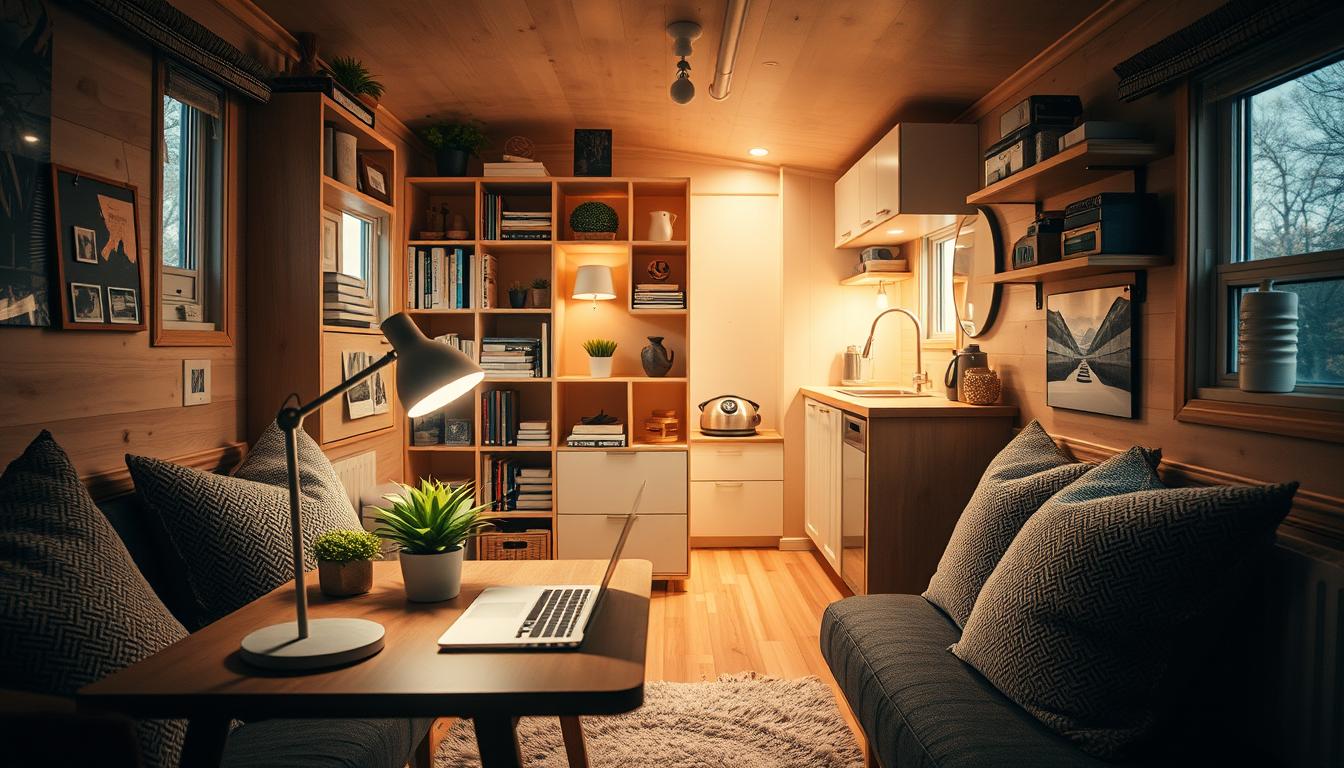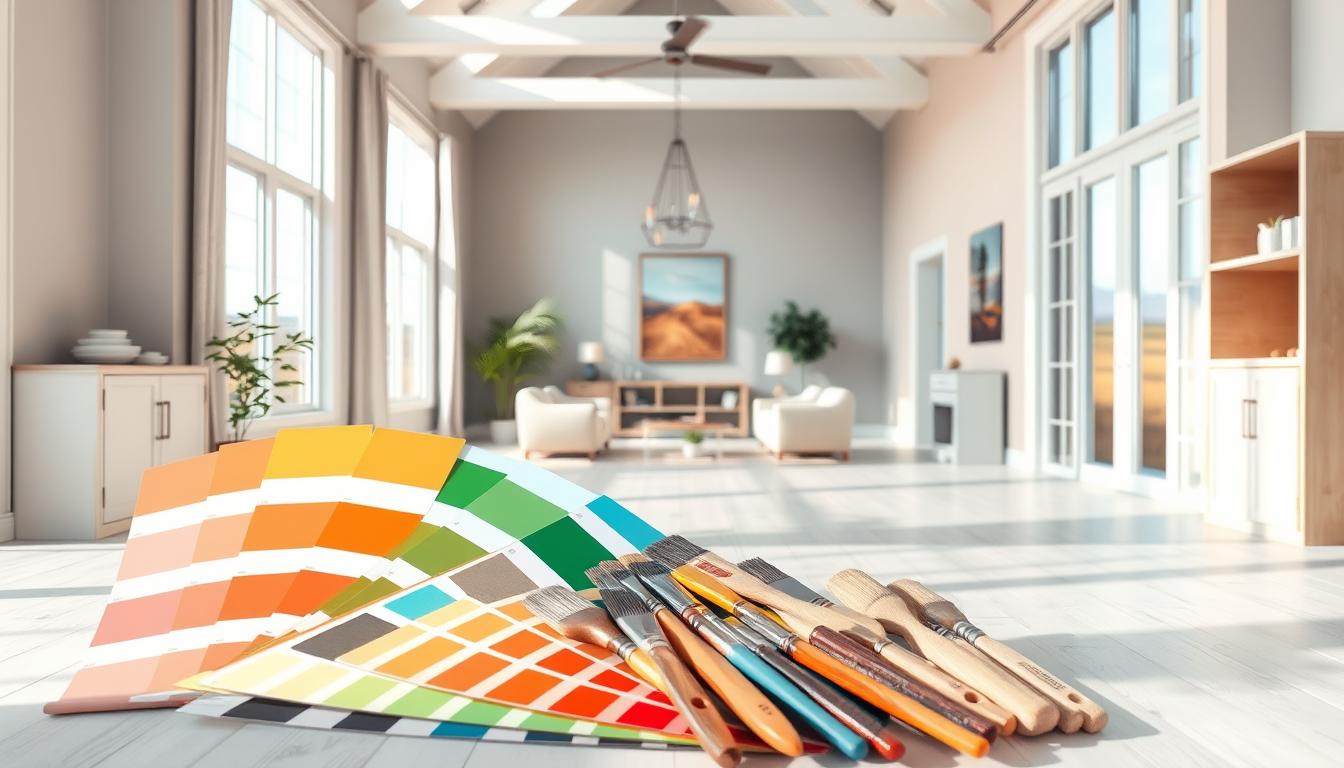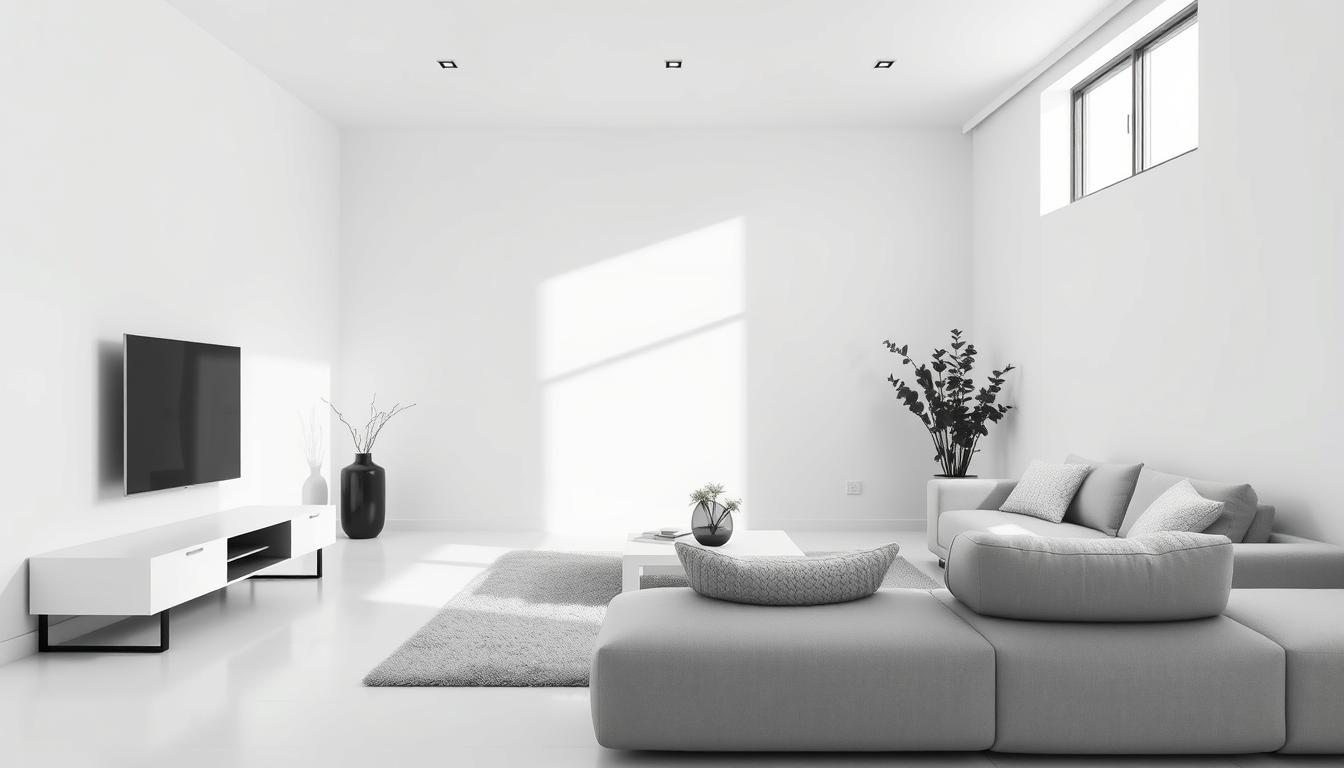Did you know that the average tiny home is just 186 square feet?
With such limited space, efficient design is key. We’ll look at how to make a cozy and functional living area.
Maximizing space in small homes needs careful planning. We’ll show you how to use multi-functional furniture and efficient storage solutions to make the most of your space.
Key Takeaways
- Efficient design is crucial in tiny homes.
- Multi-functional furniture maximizes space.
- Efficient storage solutions are essential.
- Careful planning creates a cozy living area.
- Small space decor requires creativity.
Understanding Tiny Home Living
Tiny home living has become popular for its simplicity, sustainability, and cost-effectiveness. It offers a unique blend of minimalism and practicality. This makes it an appealing choice for those seeking alternatives to traditional housing.
Benefits of Tiny Home Living
Living in a tiny home has many advantages. It uses less energy and lowers utility bills, making it eco-friendly. Key benefits include less energy use, simpler living, and lower maintenance costs.
- Reduced energy consumption and lower utility bills
- Simplified living with less clutter
- Lower costs for maintenance and repairs
Challenges of Tiny Home Living
While tiny homes offer many benefits, they also come with challenges. Limited space is a major issue, making it hard to have guests or personal space. You need to plan carefully to make the most of the space available.
- Limited space for belongings and guests
- Potential zoning and regulatory issues
- Adjusting to a simpler way of living
Key Principles of Tiny Home Interior Design
The art of tiny home interior design is about finding a balance. It’s important to make the most of the space while keeping it cozy and inviting.
Functionality
Functionality is key in tiny home design. Every piece must have a purpose, from multi-functional furniture to smart storage. For example, a tiny house interior design that focuses on function can make the space more livable.
- Choose furniture that does more than one thing, like sofa beds or Murphy beds.
- Use wall space with shelves or storage units.
- Pick items that are small but still useful, like foldable tables and chairs.
Minimalism
Minimalism is also crucial in tiny home design. It helps create a sense of openness and calm. Minimalist design also cuts down on clutter, making the space feel bigger and easier to manage.
- Stick to a few colors that go well together.
- Pick decor that looks good and serves a purpose.
- Stay away from too many extras that can make the space feel cramped.
By focusing on function and minimalism, you can make a tiny home that’s both stunning and practical.
Choosing the Right Color Palette
A good color palette is key for tiny homes to feel cozy and big. The right colors can make your home look bigger. This makes it feel more welcoming and snug.
Light Colors to Add Space
Light colors are great for small space decor because they reflect light. This makes rooms look bigger. White, cream, and soft pastels are good choices.
Think about your home’s natural light when picking colors. It changes how colors look during the day.
Using the same light color all over can make your space feel even bigger. For example, different blues can make your home feel calm and airy.
Accent Colors for Character
Light colors make a space look bigger, but accent colors add personality. Use them in furniture, textiles, or decor. These colors draw the eye, adding interest and depth.
In cozy small home design, mix light colors with accent colors. For example, a white wall can be paired with bright throw pillows or bold art. This adds beauty.
When picking accent colors, think about the look you want. Warm colors like oranges and reds make a cozy feel. Cool colors like blues and greens make a space feel fresh and big.
Selecting Multi-Functional Furniture
Using multi-functional furniture is key in tiny home design. It makes your living space both efficient and cozy.
Multi-functional furniture does more than one thing. This means you need fewer pieces, saving you space.
Sofa Beds
Sofa beds are perfect for tiny homes. They offer a comfy place to sit and sleep, all in one.
Murphy Beds
Murphy beds are another smart choice. They fold up against the wall, giving you back your floor space.
Foldable Tables and Chairs
Foldable tables and chairs are great for saving space. They’re easy to set up and fold away when not in use.
Smart Storage Solutions
In tiny home design, using space wisely is key. Smart storage solutions help a lot. They make living simple and efficient.
Utilizing Vertical Space
Vertical space is very valuable in tiny homes. It offers many chances for creative storage. Wall-mounted shelves and organizers keep floors clear, making the space feel bigger.
- Install shelving units that go up to the ceiling to maximize storage.
- Use hanging organizers for items like bikes, accessories, or kitchen utensils.
- Opt for wall-mounted tables or foldable desks to save floor space.
As minimalist living fans say, having less means less to store. But for must-haves, vertical space is a big help.
Innovative Hidden Storage
Hidden storage is another smart move in tiny homes. It keeps things looking good while hiding clutter.
| Storage Solution | Description | Benefit |
|---|---|---|
| Under-bed storage | Using the space under beds for storing items like linens, out-of-season clothes, or luggage. | Keeps items out of the way but easily accessible. |
| Ottoman storage | Storage ottomans that can hold items like throw blankets, books, or board games. | Multifunctional, serving as both seating and storage. |
| Hidden compartments | Creating or using furniture with hidden compartments for storing valuable or sensitive items. | Provides security and keeps valuable items out of sight. |
Interior design experts say tiny home living is about using every inch wisely.
With these smart storage ideas, we can have a tidy, organized home. It shows off the beauty of minimalist living and compact home design.
“The ability to simplify means to eliminate the unnecessary so that the necessary may speak.” – Hans Hofmann
Creating Open and Airy Spaces
In tiny homes, making spaces open and airy is key. This invites relaxation and comfort. Natural light makes a tiny home feel bigger and more welcoming.
Think about your tiny home’s layout. A good layout can make your home feel more spacious.
Importance of Layout
The layout of your tiny home is very important. We suggest an open floor plan. This helps avoid feeling trapped in small rooms.
- Removing unnecessary walls or partitions can open up the area.
- Choose few, multi-functional furniture pieces to cut down on clutter.
- Plan your home’s flow to make it feel spacious and easy to move around.
Using Mirrors for Depth
Mirrors are great for small spaces. They make your home look bigger by reflecting light and images. Placing mirrors wisely can make your tiny home feel larger and airier.
Here are some tips for using mirrors well:
- Put a big mirror opposite a window to reflect natural light and views, adding depth.
- Use a mirrored wall or small mirrors to make a space look bigger.
- Place a mirror opposite a light source to reflect it and brighten the area.
By using these strategies, you can make your tiny home feel open and airy. It will be welcoming and comfortable.
Cozy and Inviting Interiors
To make a tiny home cozy, focus on warmth and comfort. Use the right textiles and lighting for this.
Textiles are key to coziness. Soft blankets, plush rugs, and comfy upholstery invite you in. Pick colors and textures that match your home’s look.
Textiles and Fabrics
Go for materials that feel good and look great. Wool and cotton are top picks for their comfort and style.
Lighting Techniques
Layered lighting makes a space cozy. Mix overhead lights, table lamps, and floor lamps. Warm-toned bulbs add to the coziness.
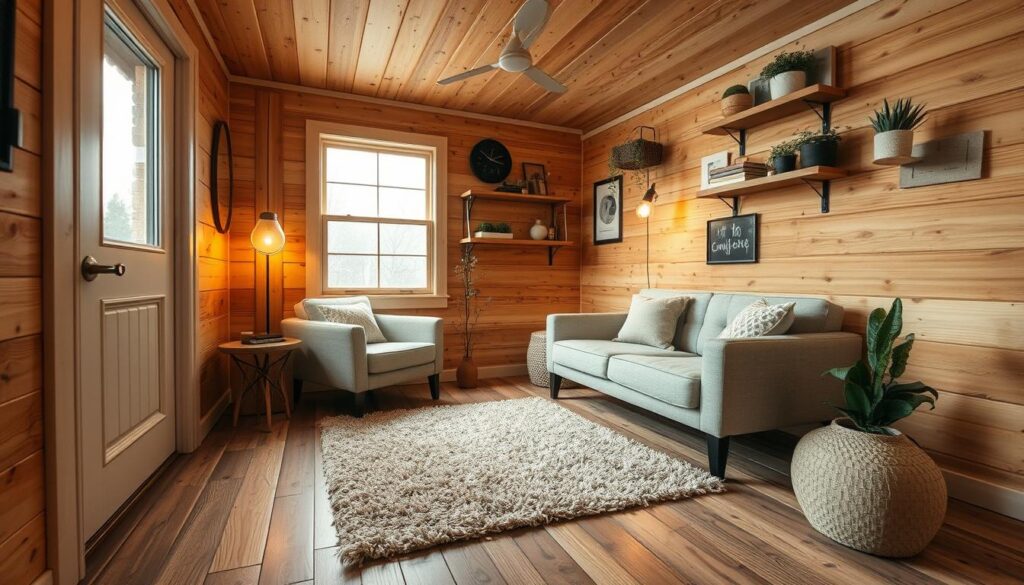
Designing for Sustainability
As we move towards a more environmentally conscious lifestyle, designing our tiny homes with sustainability in mind is crucial.
It not only reduces our ecological footprint but also creates a healthier living space.
We can achieve this by incorporating eco-friendly materials and energy-efficient appliances into our tiny home design.
Eco-Friendly Materials
Materials like reclaimed wood, bamboo, and low-VOC paints are excellent choices.
- Reclaimed wood adds a unique touch and reduces waste.
- Bamboo is highly renewable and durable.
- Low-VOC paints improve indoor air quality.
| Material | Benefits |
|---|---|
| Reclaimed Wood | Unique, reduces waste |
| Bamboo | Durable, renewable |
| Low-VOC Paints | Improves air quality |
Personalizing Your Tiny Home
Personalizing your tiny home turns a small space into a cozy haven. It’s about making it feel like home, where everything shows your personality and style.
Incorporating Personal Touches
Adding personal touches to your tiny home design can really change it. You can hang family photos, display heirlooms, or showcase personal mementos that share your story.
Using personal items brings character and warmth. Think about showing off your collections or favorite artwork.
Art and Decor Ideas
Art and decor are key to making your tiny home unique. The right pieces can boost its look and make it feel welcoming.
Look into local artwork or pieces that match your style. Decorative items like vases, sculptures, or textiles can also add interest.
| Decor Idea | Description | Benefit |
|---|---|---|
| Local Artwork | Pieces created by local artists | Adds a personal touch and supports local talent |
| Textiles | Rugs, throw blankets, and pillows | Enhances coziness and visual appeal |
| Decorative Items | Vases, sculptures, and other ornaments | Adds visual interest and personality |
By adding these elements, you can make your tiny home both functional and a true reflection of you.
Outdoor Integration
Adding the outdoors to our tiny home design can change everything. It gives us more space and connects us to nature. By making our outdoor area part of our home, we make living better.
Expanding Living Space Outdoors
To make our outdoor space great, we need furniture that looks good and works well. Think about using modular sofas and foldable tables.
When setting up our outdoor area, think about how we’ll use it. We might want a dining area or a relaxation zone. It depends on what we like and need.
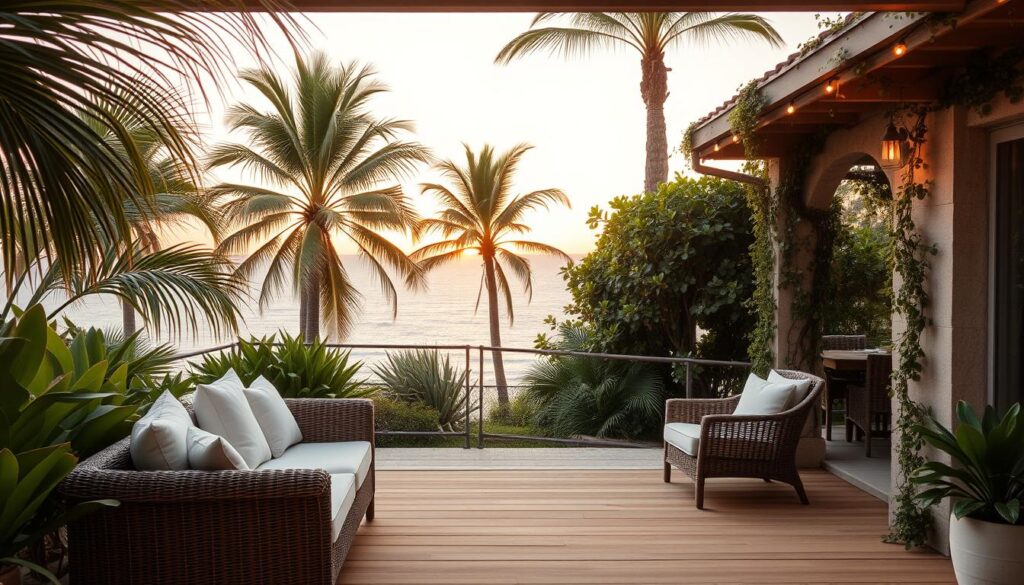
Outdoor Furniture Choices
Picking the right outdoor furniture is key. We need things that last, don’t get ruined by the weather, and are easy to keep clean. Recycled plastic furniture and wicker furniture are good choices.
| Furniture Type | Benefits | Considerations |
|---|---|---|
| Modular Sofas | Flexible, space-saving, comfortable | May require assembly, can be expensive |
| Foldable Tables | Space-saving, versatile, easy to store | May not be as sturdy, can be prone to scratches |
| Recycled Plastic Furniture | Durable, eco-friendly, low maintenance | May not be as aesthetically pleasing, can be heavy |
By picking our outdoor furniture wisely and planning our outdoor space, we can make a smooth transition between inside and outside. This makes living in our tiny home even better.
Technology in Tiny Homes
Technology is changing how we live in tiny homes, making them more efficient and connected. We’re always looking for ways to make our tiny homes better. Technology is a big help in this.
Smart home devices let us control our homes with our phones. This makes living easier and helps us save energy.
Smart Home Devices
Smart home devices make our lives simpler. They include thermostats that learn our preferences and lights that change with the day. These devices turn tiny homes into tech wonders.
- Voice Assistants: Devices like Amazon Echo and Google Home let us control our homes with voice commands. This makes managing our space easier.
- Smart Lighting: Remote-controlled LED bulbs help us save energy by adjusting to our needs.
- Home Security: Smart locks and cameras add safety and security to our homes.
A tech expert says, “Smart home tech is essential for modern living.” This is even more true for tiny homes, where space is limited and efficiency is key.
“The future of tiny homes is not just about being small; it’s about being smart.”
Maintaining Connectivity
Staying connected is important today. For those living in tiny homes, having reliable internet and staying in touch is crucial.
| Connectivity Solutions | Features | Benefits |
|---|---|---|
| Mobile Hotspots | Portable, secure, and easy to use | Stay connected on the go |
| Satellite Internet | Reliable, wide coverage area | Access internet from anywhere |
| Cellular Signal Boosters | Amplifies weak signals, improves call quality | Enhanced communication |
Using these technologies keeps our tiny homes connected, efficient, and comfortable.
Tips for Decorating Tiny Spaces
Decorating a tiny space is all about finding the right balance. You need to make every choice count because space is limited. This means every piece of furniture and decor should have a purpose.
Layering Textures
Layering textures adds depth and interest to small areas. Mixing different materials and finishes creates a cozy feel. Try combining smooth surfaces like glass or metal with rougher textures like wood or woven fibers.
- Use throw blankets and rugs to add warmth and tactility.
- Incorporate natural elements like plants or a vase with branches.
- Mix metallic accents with matte finishes to create visual contrast.
Balancing Aesthetics with Function
In tiny homes, it’s key to balance looks with function. Each piece of furniture or decor should look good and serve a purpose. Multi-functional furniture is a smart choice for this balance.
- Opt for a storage ottoman that doubles as a coffee table.
- Choose a murphy bed or a sofa bed to maximize sleeping space.
- Select furniture with built-in storage to keep clutter at bay.
By following these decorating tips, you can make a tiny home both stylish and practical. The secret to great small space decor is being thoughtful with every choice.
Real-Life Tiny Home Examples
Looking at real tiny homes can inspire us. It shows how to make the most of small spaces. We can pick up practical ideas for our own tiny homes.
Practical Inspiration
Many tiny home owners have made their spaces both useful and beautiful. Some use loft areas for beds, while others have sliding glass doors. These ideas show the power of creativity in tiny home design.
Applying the Lessons
Learning from these examples helps us design our tiny homes better. We can use multi-functional furniture or choose colors wisely. The goal is to make our space feel open and welcoming. By using these ideas, we can create a home that looks good and works well.

